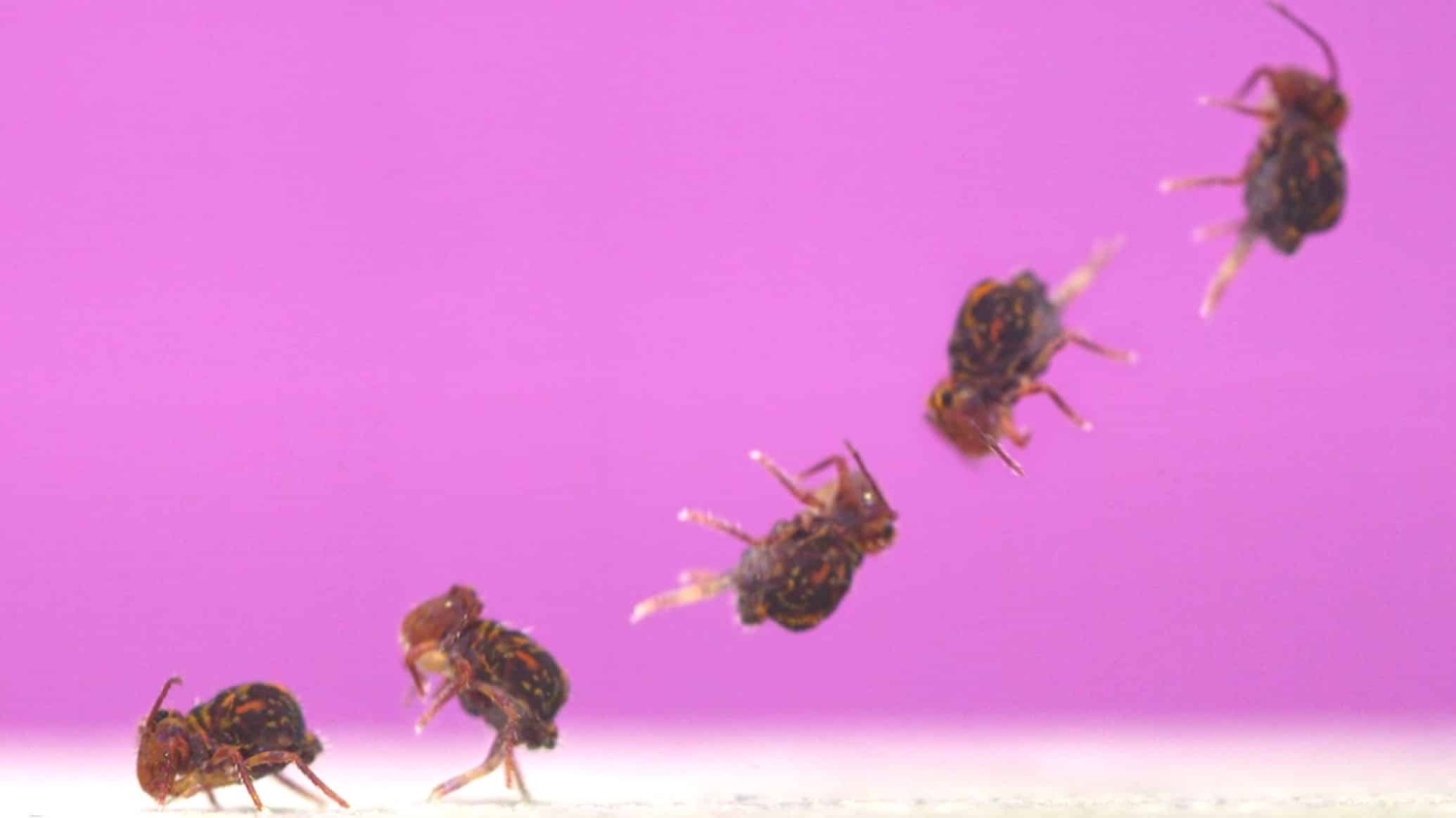For Immediate Release
Move over, Sonic. There’s a new spin-jumping champion in town – the globular springtail (Dicyrtomina minuta). This diminutive hexapod backflips into the air, spinning to over 60 times its body height in the blink of an eye, and a new study features the first in-depth look at its jumping prowess.
Globular springtails are tiny, usually only a couple millimeters in body length. They don’t fly, bite or sting. But they can jump. In fact, jumping is their go-to (and only) plan for avoiding predators. And they excel at it – to the naked eye it seems as though they vanish entirely when they take off.
“When globular springtails jump, they don’t just leap up and down, they flip through the air – it’s the closest you can get to a Sonic the Hedgehog jump in real life,” says Adrian Smith, research assistant professor of biology at North Carolina State University and head of the evolutionary biology and behavior research lab at the North Carolina Museum of Natural Sciences. “So naturally I wanted to see how they do it.”
Finding the globular springtails was easy enough – they’re all around us. The ones in this study are usually out from December through March. Smith “recruited” his research subjects by sifting through leaf litter from his own backyard. But the next part proved to be the most challenging.
“Globular springtails jump so fast that you can’t see it in real time,” Smith says. “If you try to film the jump with a regular camera, the springtail will appear in one frame, then vanish. When you look at the picture closely, you can see faint vapor trail curlicues left behind where it flipped through the one frame.”
Smith solved that problem by using cameras that shoot 40,000 frames per second. He urged the springtails to jump by shining a light on them or lightly prodding them with an artist’s paintbrush. Then he looked at how they took off, how fast and far they went, and how they landed. A video explanation of this research can be found here.
Globular springtails don’t use their legs to jump. Instead, they have an appendage called a furca that folds up underneath their abdomen and has a tiny, forked structure at its tip. When the springtails jump, the furca flips down and the forked tip pushes against the ground, launching them into a series of insanely fast backflips.
What do we mean by insanely fast?
“It only takes a globular springtail one thousandth of a second to backflip off the ground and they can reach a peak rate of 368 rotations per second,” Smith says. “They accelerate their bodies into a jump at about the same rate as a flea, but on top of that they spin. No other animal on earth does a backflip faster than a globular springtail.”
The springtails were also able to launch themselves over 60 millimeters into the air – more than 60 times their own height. And in most cases, they went backward.
“They can lean into a jump and go slightly sideways, but when launching from a flat surface, they mostly travel up and backward, never forward,” says Jacob Harrison, a postdoctoral researcher at the Georgia Institute of Technology and paper co-author. “Their inability to jump forward was an indication to us that jumping is primarily a means to escape danger, rather than a form of general locomotion.”
Landing was found in two styles: uncontrolled and anchored. Globular springtails do have a sticky forked tube they can evert – or push out of their bodies – to grapple a surface or halt their momentum, but Smith observed that bouncing and tumbling to a stop was just as common as anchored landings.
“This is the first time anyone has done a complete description of the globular springtail’s jumping performance measures, and what they do is almost impossibly spectacular,” Smith says. “This is a great example of how we can find incredible, and largely undescribed, organisms living all around us.”
The work appears in Integrative Organismal Biology. Smith is the corresponding author.
-peake-
Note to editors: An abstract follows.
“Jumping performance and behavior of the globular springtail Dicyrtomina minuta”
DOI: 10.1093/iob/obae029
Authors: Adrian Smith, North Carolina State University and the North Carolina Museum of Natural Sciences; Jacob Harrison, Georgia Institute of Technology
Published: Aug. 29, 2024 in Integrative Organismal Biology
Abstract:
Springtails are among the most abundant arthropods on Earth and they exhibit unique latch-mediated spring-actuated jumping behaviors and anatomical systems. Despite this, springtail jumps have not been well described, especially for those with a globular body plan. Here, we provide a complete description and visualization of jumping in the globular springtail Dicyrtomina minuta. A furca-powered jump results in an average take-off velocity of 1 ms-1 in 1.7 ms, with a fastest acceleration to liftoff of 1,938 ms-2. All jumps involve rapid backwards body rotation throughout, rotating on average at 282.2 Hz with a peak rate of 368.7 Hz. Despite body lengths of 1-2 mm, jumping resulted in a backwards trajectory traveling up to 102 mm in horizontal distance and 62 mm in vertical. Escape jumps in response to posterior stimulation did not elicit forward-facing jumps, suggesting that D. minuta is incapable of directing a jump off a flat surface within the 90° heading directly in front of them. Finally, two landing strategies were observed: collophore-anchoring which allows for an immediate arrest and recovery, and uncontrolled landings where the springtail chaotically tumbles. In comparison to other fast jumping arthropods, linear performance measures globular springtail jumps place them between other systems like fleas and froghoppers. However, in angular body rotation, globular springtails like D. minuta surpass all other animal systems. Given the extraordinary performance measures, unique behavioral responses, and understudied nature of these species, globular springtails present promising opportunities for further description and comparison.
This post was originally published in NC State News.
- Categories:



